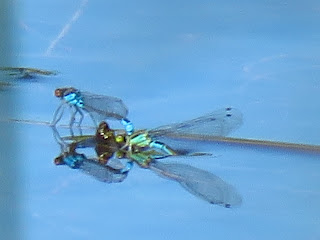A start with sunny spells, for the clouds to part as the morning progressed, ending in a warm day, ideal for flying insects. My first stop is the Beverley and Barmston Drain by Beresford Avenue. It doesn't take long to find a Willow Emerald. On the way back, when is warmer and more of the water is in sunshine, I make another stop. Then I find three Willow Emeralds, on trees lining the drain and on marginal vegetation. There is also a patrolling Emperor and several Common Darter.
A young Robin basking.
I carry on along the river bank. I hear a Reed Warbler alarm from a patch of reeds. After some waiting I notice there are two fledglings just visible. My first fledged Reed Warblers, nice to see they are being successful by the river. There are two other alarmed Reed Warblers between Oak Road and Sutton Bridge, but I see no trace of Reed Buntings.
The South Pond is looking amazing, and I end up having my lunch break there. There is plenty of milfoil, with the flowering spikes offering convenient resting spots for scores of Small Red-eyed Damselflies and Common Blue Damselflies.
This is a relatively recent pond that has changed quite a lot in the last few years. The marginal belt of reeds and other plants has grown considerably. The pond is fenced up, but the gate is open, so I walk around and end up sitting with my lunch in one of the openings in the vegetation. A female Emperor is ovipositing on the edge of the pond, while at least two males, one of them with a defective leg, sparr and patrol the pond.
I watch her for a while and take some videos. Then, a Moorhen makes a splash and when I focus my binoculars on it, I realised it's got an Emperor! It must have been an ovipositing female, which are more vulnerable. Before I can get a photo, the Moorhen has given the emperor to its chick. It looks like a very odd thing to do, but the chick takes it happily and moves into the reeds. Although I knew Moorhens fed on small invertebrates, I would have never expected them to take an Emperor.
The adult moorhen has just given the Emperor to its chick.
I continue watching the dragonflies and documenting breeding evidence for the pond.
Mallard catching damselflies.































No comments:
Post a Comment